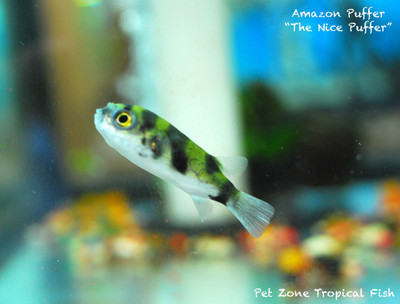The Amazon Pufferfish: A Fascinating Aquatic Species
Posted by Max Gandara on on 19th Sep 2023
The Amazon Pufferfish, scientifically known as Tetraodon fluviatilis, is
a captivating and unique aquatic species found in the freshwater
systems of the Amazon Basin and surrounding regions. Renowned for their
distinctive appearance, intriguing behaviors, and specialized
adaptations, these small, yet charismatic creatures have garnered
attention from both aquarium enthusiasts and researchers. In this
article, we will delve into the world of Amazon Pufferfish, exploring
their biology, habitat, behavior, and their popularity in the aquarium
trade.
The Amazon Pufferfish belongs to the family Tetraodontidae, which is
commonly referred to as the "pufferfish" family. Pufferfish are known
for their ability to inflate their bodies when threatened, making them
appear larger and deterring potential predators. Tetraodon fluviatilis,
in particular, is classified under the genus Tetraodon. These pufferfish
are often recognized by their compact body shape, tiny fins, and sharp
beaks, which they use to crush and consume a variety of prey items.
Amazon Pufferfish exhibit a remarkable range of physical characteristics
that contribute to their distinctive appearance and behaviors. Their
bodies are covered in tough, spiky skin that provides a level of
protection against predators. They have a relatively small size,
typically reaching lengths of 3 to 4 inches (7.5 to 10 centimeters),
although larger individuals have been documented.
One of the most striking features of Amazon Pufferfish is their large,
expressive eyes that can move independently, allowing them to scan their
surroundings for potential threats or prey. They also possess a
beak-like mouth, which is highly adapted for crushing the hard
exoskeletons of their preferred prey, such as snails, crustaceans, and
small insects.
Amazon Pufferfish are primarily found in the freshwater systems of South
America, particularly in the Amazon Basin, the Orinoco Basin, and
various other river systems throughout the region. They are highly
adaptable and are known to inhabit slow-moving rivers, flooded forests,
and oxbow lakes, where they can find suitable food sources and
vegetation.
Within their natural habitats, Amazon Pufferfish prefer areas with ample
hiding spots, such as submerged logs, aquatic plants, and dense
vegetation. These hiding places offer protection from predators and
serve as ideal locations for ambushing prey.
The behavior of Amazon Pufferfish is characterized by their
inquisitiveness and territorial nature. They are known to be curious
fish, often exploring their surroundings with their keen sense of sight.
Despite their small size, they can be quite territorial and may become
aggressive towards other fish that encroach upon their chosen territory.
Diet-wise, Amazon Pufferfish are carnivorous and have a penchant for
hard-shelled invertebrates. They are skilled hunters, using their
beak-like mouths to crush the shells of snails, crustaceans, and other
small prey. In captivity, providing a diverse diet that includes a
variety of protein-rich foods is crucial to their health and well-being.
Amazon Pufferfish have gained popularity in the aquarium trade due to
their unique appearance and intriguing behaviors. However, they require
specialized care to thrive in captivity. Keeping Amazon Pufferfish in an
aquarium requires attention to water quality, appropriate tank size,
and a well-rounded diet. They are sensitive to changes in water
parameters and should be kept in stable conditions with clean,
well-maintained water.
A suitable aquarium for Amazon Pufferfish should have ample hiding
places, such as caves or plants, to mimic their natural habitat. Tank
mates should be carefully selected, as Amazon Pufferfish can be
territorial and may not tolerate the presence of other pufferfish or
aggressive fish species.
The Amazon Pufferfish is a captivating aquatic species native to the
Amazon Basin and surrounding regions. Their unique physical
characteristics, curious behaviors, and specialized adaptations make
them a sought-after addition to the aquarium hobby. However, their care
demands attention to detail and a commitment to providing an environment
that mimics their natural habitat. As stewards of these fascinating
creatures, it is essential to ensure their well-being and conservation
in both their native habitats and captivity.

